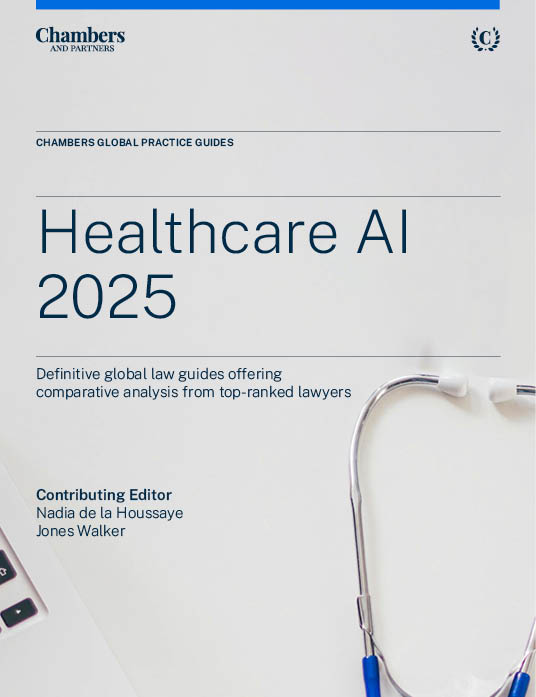
Healthcare AI 2025
The new Chambers Healthcare AI 2025 guide covers the latest legal information on the use of AI in healthcare across the Asia-Pacific region, Europe and North America. The guide provides up-to-date commentary and analysis on the legal framework for and regulatory oversight of healthcare AI, the nature of liability and risk in the sector, ethical and governance considerations, data privacy and protection, IP issues, future trends and regulatory developments, and practical considerations for healthcare AI developers and users.
Last Updated: August 06, 2025
Compare law and practice by selecting locations and topic(s)
Select Locations

Select Topic(s)

Please select at least one location and one topic to use the compare functionality.
Navigating the Convergence of Innovation, Regulation and Clinical Practice in an Era of Transformation
The global healthcare artificial intelligence (AI) landscape stands at an unprecedented inflection point. As 2025 progresses, the convergence of technological innovation, evolving regulatory frameworks and mounting healthcare delivery pressures has created both extraordinary opportunities and complex challenges that transcend national boundaries. From Silicon Valley start-ups to established pharmaceutical giants, and from rural clinics in developing nations to world-renowned academic medical centres, stakeholders across the healthcare AI ecosystem are grappling with fundamental questions about how to harness the transformative potential of AI while ensuring patient safety, regulatory compliance and equitable access to care.
The pace of innovation in healthcare AI continues to accelerate across all major jurisdictions. Machine learning algorithms now assist radiologists in detecting cancers, support clinicians in predicting patient outcomes and enable pharmaceutical companies to accelerate drug-discovery processes. Natural language processing tools automate clinical documentation, while predictive analytics optimise hospital operations and resource allocation.
This technological revolution extends far beyond diagnostic applications to encompass therapeutic planning, administrative functions and population health management, fundamentally reshaping how healthcare is delivered, managed and regulated worldwide.
The Global Regulatory Patchwork
Perhaps no aspect of healthcare AI presents greater complexity than the evolving regulatory landscape. Jurisdictions around the world are taking markedly different approaches to AI governance, creating a challenging patchwork of requirements that healthcare AI developers and users must navigate. The EU’s Artificial Intelligence Act represents one of the most comprehensive attempts to regulate AI, establishing risk-based classifications that significantly impact healthcare applications. High-risk AI systems used in healthcare face stringent requirements for transparency, human oversight and post-market surveillance, while the EU’s medical device regulations continue to evolve to address AI-specific challenges.
In the United States, the Food and Drug Administration has pioneered regulatory pathways for AI-enabled medical devices, authorising over 900 such systems through August 2024 while developing innovative approaches such as predetermined change control plans to accommodate continuously learning algorithms. Meanwhile, Asian markets present their own unique regulatory environments, with countries including Japan, Singapore and South Korea developing specialised frameworks for healthcare AI that balance innovation promotion with patient protection.
This regulatory fragmentation creates particular challenges for healthcare AI companies seeking to operate across multiple jurisdictions. What constitutes adequate clinical validation in one country may not satisfy requirements in another. Privacy and data protection standards vary significantly, with the EU’s General Data Protection Regulation (GDPR) setting a high bar that other jurisdictions may not match. Healthcare AI developers must increasingly design compliance strategies that can adapt to multiple regulatory regimes while maintaining product integrity and commercial viability.
Data Governance and Privacy Imperatives
Healthcare AI’s dependence on vast datasets for training and validation creates complex data governance challenges that vary significantly across jurisdictions. The intersection of healthcare data protection laws with AI development requirements presents one of the most pressing compliance challenges facing the industry. In Europe, the GDPR’s strict consent requirements and data minimisation principles can conflict with AI systems’ need for comprehensive datasets. The right to explanation provisions may challenge the “black-box” nature of certain machine learning algorithms, while data portability requirements complicate cross-border AI development efforts.
Similar tensions emerge in other jurisdictions with robust healthcare privacy frameworks. The United States’ Health Insurance Portability and Accountability Act (HIPAA) regulations, while predating modern AI systems, continue to govern how protected health information can be used in AI development and deployment. Countries with emerging digital health initiatives must balance the potential benefits of AI innovation against the imperative to protect patient privacy and maintain public trust in healthcare systems.
The secondary use of healthcare data for AI training presents particular challenges. Clinical data originally collected for patient care purposes requires careful consideration of consent frameworks, de-identification standards and cross-border transfer restrictions when repurposed for AI development. Synthetic data generation and federated learning approaches offer promising solutions, but these technologies themselves raise novel legal and technical questions that regulatory frameworks must address.
Algorithmic Bias and Health Equity
The global healthcare AI community increasingly recognises that algorithmic bias represents one of the most significant ethical and legal challenges facing the field. Training datasets that inadequately represent diverse patient populations can perpetuate or exacerbate existing healthcare disparities, potentially undermining the very goals that AI seeks to achieve. This concern transcends geographic boundaries, as healthcare inequities exist in virtually every healthcare system worldwide.
The challenge is particularly acute in global contexts where AI systems developed in one region may be deployed in populations with significantly different demographic, genetic or socioeconomic characteristics. An AI diagnostic tool trained primarily on data from European or North American populations may perform poorly when applied to patients in sub-Saharan Africa or Southeast Asia. This creates both technical challenges related to algorithm generalisability and ethical obligations to ensure that AI innovation benefits all populations equitably.
Regulatory responses to algorithmic bias vary significantly across jurisdictions. Some countries are developing specific requirements for bias testing and mitigation, while others rely on broader anti-discrimination frameworks. Healthcare AI developers must increasingly implement systematic approaches to bias detection and remediation that can meet varying international standards while advancing the broader goals of health equity.
Professional Liability in the Age of AI
The integration of AI into clinical practice raises novel questions about professional liability and standards of care that legal systems worldwide are struggling to address. Traditional medical malpractice frameworks assume human decision-making processes that may not adequately account for algorithm-assisted care. When AI systems provide diagnostic recommendations or treatment suggestions, determining liability for adverse outcomes becomes complex, particularly when multiple stakeholders – including healthcare providers, AI developers and healthcare institutions – may share responsibility.
Different legal systems approach these challenges in varying ways. Common-law jurisdictions may rely on evolving case law to establish standards for AI-assisted care, while civil-law systems may require more explicit legislative or regulatory guidance. Professional medical organisations across the globe are developing guidelines for responsible AI use, but these standards are not uniform and may not have the force of law.
Healthcare providers worldwide must increasingly document their interactions with AI systems, demonstrating appropriate clinical judgment in accepting, modifying or rejecting algorithmic recommendations. This documentation burden varies across jurisdictions but represents a common challenge as healthcare AI adoption accelerates globally.
Market Dynamics and Innovation Ecosystems
The global healthcare AI market reflects broader patterns of technological innovation and investment, with significant activity concentrated in major technology hubs while emerging markets present both opportunities and challenges. North American and European companies continue to lead in healthcare AI development, supported by robust venture capital ecosystems and sophisticated regulatory frameworks. Asian markets, particularly China, Japan and Singapore, are rapidly emerging as significant players with substantial government support for AI innovation.
However, the global nature of healthcare challenges creates opportunities for AI solutions to address universal needs. Telemedicine platforms enhanced by AI can extend specialist expertise to underserved regions, AI-powered diagnostic tools can support healthcare delivery in resource-constrained environments and drug discovery platforms can accelerate the development of treatments for neglected diseases that disproportionately affect developing world populations.
Cross-border collaboration in healthcare AI development is becoming increasingly common, but these partnerships must navigate complex regulatory, intellectual property and data transfer requirements. Academic medical centres are forming international research consortia to develop AI solutions, while technology companies are establishing global partnerships to access diverse datasets and clinical expertise.
Intellectual Property and Technology Transfer
Healthcare AI innovation raises complex intellectual property questions that vary significantly across jurisdictions. Patent protection for AI algorithms and applications differs among countries, with some offering robust protection for software innovations while others maintain more restrictive approaches to algorithm patentability. Copyright protection for training data, code and AI-generated outputs presents additional challenges that intellectual property frameworks are still adapting to address.
The global nature of AI development complicates traditional intellectual property strategies. Training datasets may incorporate information from multiple countries, AI algorithms may be developed collaboratively across international teams and deployment may occur in jurisdictions with varying IP protections. Healthcare AI companies must develop comprehensive intellectual property strategies that account for these complexities while protecting their competitive advantages.
Future Horizons and Strategic Considerations
As healthcare AI continues to evolve, several trends will likely shape the global landscape over the coming years. Regulatory harmonisation efforts may reduce some of the current fragmentation, but significant differences in national approaches to AI governance are likely to persist. International standards organisations are working to develop common frameworks for healthcare AI, but adoption will depend on national regulatory agencies and may not be uniform.
The emergence of more sophisticated AI technologies, including large language models and generative AI applications, will create new regulatory and ethical challenges that existing frameworks may not adequately address. Healthcare organisations must prepare for continuous adaptation as both technology and regulation evolve.
Conclusion: A Call for Co-Ordinated Action
The global healthcare AI revolution presents unprecedented opportunities to improve patient outcomes, enhance healthcare delivery efficiency and address pressing public health challenges. However, realising this potential requires co-ordinated action among healthcare providers, technology developers, regulators and legal professionals worldwide.
Legal practitioners serving healthcare AI stakeholders must develop a deep understanding of AI’s technological capabilities and regulatory requirements across multiple jurisdictions. This requires ongoing education about emerging technologies, active monitoring of regulatory developments and collaboration with technical experts to ensure that legal advice reflects current realities.
Success in this environment demands proactive compliance strategies that can adapt to evolving requirements while supporting innovation goals. Healthcare AI stakeholders must invest in robust governance frameworks, comprehensive risk management programmes and ethical development practices that meet international standards while advancing patient care objectives.
As the articles in this guide demonstrate, the challenges facing healthcare AI are both jurisdiction-specific and globally interconnected. Legal professionals who can navigate this complexity while supporting responsible innovation will play crucial roles in shaping the future of healthcare AI and ensuring that its benefits are realised safely, equitably and sustainably worldwide.
